
| Type of paper: | Essay |
| Categories: | Media Public relations Leadership style |
| Pages: | 2 |
| Wordcount: | 414 words |
Technology has ushered in social media as the new mobilizing technique by leaders. It has been the 'go to' approach to keeping members of an organization informed. Leaders have embraced social media to get closer to their members and the public. Twitter, for instance, gives a chance to organization leadership to build web-based relationships with the public, however, this depends on the on web technology interactivity level by a given organization (Adam J Saffer, Enrich J Sommerfeldt, Maureen Taylor, 2013). Social media also offers the leader a chance to study and understand human interactions and collective behavioral tendencies (Lei Tang, Huan Liu, 2010).
Social media has dismantled the formal leadership structures of communication, which most of the time do not allow for extensive discussion. The users also have the luxury of choosing when and what information to relay and what to withhold (Yaron Ariel, Ruth Avidar, 2015). It allows for the free exchange of ideas by minimizing the authentic atmosphere where members actively participate and air grievances as well as pointing out the positives.
The leadership of any group can be able to monitor the feelings, reactions, and general atmosphere of the audience at any given time. The spread of social media has, therefore, promoted servant leadership in modern business setups, making it a favorable model of effective management (Tucker, 2017). All social media platforms have a comments section below the posts where users can react to information. This tells the leader the strides made and shortfalls, as well as how members feel about the cause in general.
Despite the advantages enjoyed by leaders, social media poses a challenge of breach of privacy. Many social networking sites (SNS) users have problems in drawing a line between what is to be posted online and that which is private business (Madden, 2012). The leaders are persons of public interest and sometimes get caught up with bizarre scandals when private information, especially photos of them finds their way onto social media feeds. Damaged reputations, shaming, and misrepresentations are some of the shortcomings of poor social media handling.
References
Adam J Saffer, Enrich J Sommerfeldt, Maureen Taylor. (2013). The effects of organizational Twitter interactivity on organization-public relationships. Public Relations Review.
Lei Tang, Huan Liu. (2010). Community detection and mining in social media. Synthesis lectures on data mining and knowledge discovery.
Madden, M. (2012). Privacy management on social media sites . Pew Internet Report.
Tucker, J. (2017). The influence of social media on 21st-century leaders. ResearchGate.
Yaron Ariel, Ruth Avidar. (2015). Information, interactivity, and social media. Atlantic Journal of Communication.
Cite this page
Essay Sample: Social Media Is the New Mobilizing Technique by Leaders. (2023, Jan 16). Retrieved from https://speedypaper.com/essays/social-media-is-the-new-mobilizing-technique-by-leaders
Request Removal
If you are the original author of this essay and no longer wish to have it published on the SpeedyPaper website, please click below to request its removal:
- Dissertation Sample: Conclusion and Recommendation - SME's Growth Strategy
- Free Essay on Data Link Layer
- Essay Sample on Strained Matrimonial Relationships
- Public Relation Analysis of Metro Trains: Dumb Ways to Die. Free Essay.
- Case Study: A Special Kind of Financing
- Essay Sample Offering a Defensible Solution to Caffeine Consumption
- Introduction to Film "Lord of the Rings: Fellowship of the Ring" - Free Essay
Popular categories




